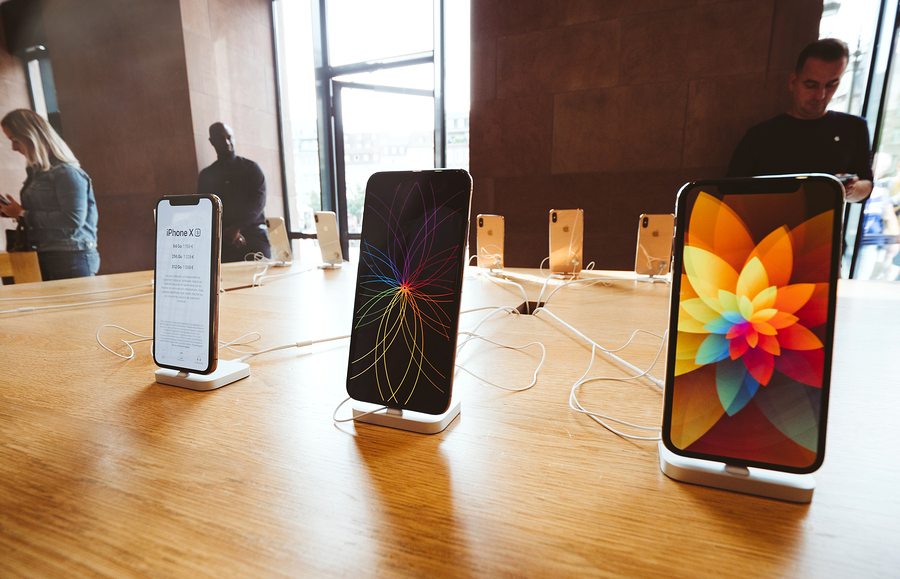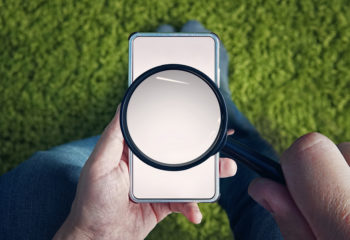We are often asked for guidance on buying an iPhone for the first time. The initial move from a feature or flip phone, or from an Android phone to an iPhone requires personalized setup, and a mix of patience and practice to adjust. The reason for switching, in this case, is the advanced accessibility iPhone offers for people with visual impairments or blindness.
The real initial setup of an iPhone only has to happen once. Next time you upgrade your iPhone, the data, apps and settings will transfer from iCloud and fill the new phone with all your stuff. This way it’s totally familiar and there’s no need to start the whole process over again with each new model.

People browsing in an Apple Store.
At The Apple Store:
What You Need to Know
The Apple Store is the best place to buy the iPhone and get it set up. It is not always so easy to get your phone set up at a mobile retail store, especially when it involves accessibility. At the Apple Store, there is a process for “Personal Setup,” and they know this phone intimately.
- iPhone model: Newer models are always best for the long term. The best model for you may be dependent on screen size. Try them in the store, ask your sales specialist to show you larger text and contrast settings to determine whether they enhance your ability to read.
- iPhone storage size: The phones come in different storage sizes. For new users, the smallest, which is now 64GB, should suffice. If you are planning to access a large photo or music library, you may want to consider more space.
- VoiceOver: For those of us unable to read the screen comfortably in any text or screen size, option 2 is learning to use VoiceOver, iPhone’s full-function screen reader. This does add to the learning curve, but totally worth the work! More on this from OE: Let iPhone’s VoiceOver Do The Reading
- Apple Care Plus: Consider Apple Care Plus for extended warranty and replacement. This can be a good thing to have, just in case.
- Apple ID and iCloud: If you already have an Apple ID and iCloud account, be prepared to provide the username and password. If not, they will be created at setup. (To lessen any potential confusion, always best to make the Apple ID and iCloud accounts the same username & password.)
- Email password: Your email address and password are also required to set the Mail app, don’t forget.
At Personal Setup:
What You Need To Do
- Set larger text, bold text, display accommodations, increase contrast (as needed)
- Transfer Contacts from previous phone (if possible)
- Set A Passcode Lock and Face ID (or don’t, it’s easier without)
- Set Auto-Lock for 5 minutes so the screen doesn’t keep locking as you are learning
- Set up “Hey Siri”
- Turn on Dictation
- Set up your email
- Make a few calls right away from the Apple Store so you know how to use the phone, then go right home and practice making calls, answering calls, ending calls
- Turn on VoiceOver or Speak Screen (if needed)
- Once the VO setting is turned on, VO can be turned on/off by asking Siri
Learning:
Here Are The Keys
The key to success is repetition. So keep in mind, if you repeat an action 25 – 30 times, it gets committed to muscle memory, and then you just begin doing it automatically. This is not a matter of technical ability, it’s simply perseverance. Everyone, regardless of visual acuity, experiences the learning curve.
For VoiceOver users, the curve is a bit steeper, but (take it from one who knows) the conquest is even sweeter! You’ll need to begin practicing the VoiceOver gestures that navigate the screen. Again, it’s all about practice, the more you touch the screen the better you become. For your reference, here’s the list of VoiceOver Gestures.
Apple Accessibility Support Phone Line: (877-204-3930) is an invaluable learning tool. A dedicated line for customers with visual, hearing, motor and learning impairments, available 24/7. Not only will they answer your questions and resolve your issues, they will also provide tutorials on the use of apps. Don’t be shy, they want to hear from you. If you’re stuck…call them. If you want to learn something new…call them. There’s no limit.
Get your learning started with these topics…
- Get familiar with Phone app: Recent calls, Contacts, Voice Mail
- Use Siri to make a call by name or phone number
- Learn to save phone numbers and emails to Contacts
- Find the ways Siri can work best for you…here are 10 Things Siri Will Do If You Ask
- Learn to send text messages
- Learn to send, and reply to, email
- Learn to use the Dictate key instead of typing… Are You A Dictator?
Practice is a must – put in an hour a day getting comfortable.
Once you’re phoning, emailing and texting with confidence, you’re ready to move on and master more apps of your choosing. The apps you use every day will become ingrained and after a while, you won’t even have to think about it.
A virtual and comprehensive catalog of iPhone courses is available at HadleyHelps.org and it’s as good as one-to-one training. They offer live expert help and phone support too, all fee-free….Meet Hadley 2.0, Your Personal Tutor.
This article was originally published Nov. 8, 2018, and updated Mar. 18, 2021.
Please note that this article was not paid for, affiliated with, or endorsed by any third-party companies. The views and opinions expressed in this article are solely those of the author’s.







